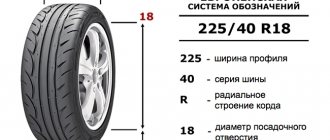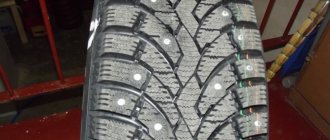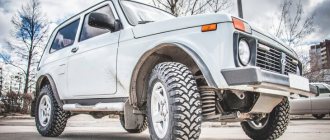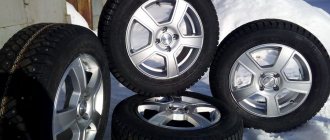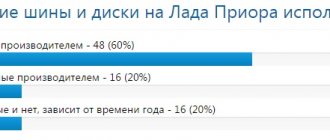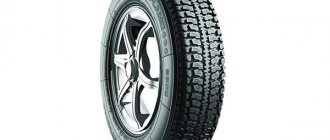Winter time requires motorists to prepare their cars for difficult weather conditions. A misconception is that in winter you can use all-season or summer tires. This type is technologically not intended for use in winter.
Many people believe that winter tires on a VAZ differ from summer tires only in the tread pattern. This is partly true, but the main difference lies not in the tread, but in the type of rubber itself. At low temperatures, rubber becomes hard and the quality of grip on the road surface decreases. The composition of winter tires is selected so that the material does not lose softness even in severe frost. This feature can explain why it is not recommended to use winter tires in summer; at positive temperatures, soft rubber will become even softer, which will complicate driving.
Often, owners consider it sufficient to install winter tires only on the drive axle, but this idea does not meet safety requirements, since the risk of skidding increases, traction forces are not balanced and there is a danger of maintaining straight-line motion when turning.
Features of winter tires for cars
Many people believe that the difference between tires designed for different seasons comes down to the tread, namely its design. This is partly true; the tread pattern of winter tires is different from that of summer tires. However, the main difference lies not in the tread, but in the rubber composition itself.
The fact is that at negative temperatures, rubber changes its properties - it becomes hard, while the quality of the grip of the “hardened” rubber decreases. In winter tires, the composition has been changed so that it remains soft even at low temperatures.
But this condition also has a negative role - such rubber becomes even softer at positive temperatures, which leads to the fact that driving the car becomes more difficult, it begins to float a little on the road. Additionally, winter tires are often equipped with metal studs to improve wheel traction on snow and ice.
However, not all winter tires...
equipped with spikes - another type of stingray is produced, without spikes. Popularly, such tires are called “Velcro” or “cobwebs”. The fine, specially applied tread of these tires provides reliable grip on winter roads even without the use of studs.
All-season tires, which are supposedly designed for both summer and winter cold, are also popular among people. This is not an entirely correct judgment; rather, these are tires for the autumn-spring period, since in summer they are not hard enough, and in winter they do not have the required softness.
So you shouldn’t take any chances, and in winter use only tires designed for this period.
So, now the market offers a large number of winter tires for cars, including for our automobile industry; winter tires are sold for VAZ classics, as well as the new generation - 21099, 2110-2114.
Related link:
Description and installation of the Alliance heater on a VAZ car
One of the significant conditions...
When choosing winter tires for a VAZ, the “wallet size” factor is considered. After all, a lot of companies, both domestic and foreign, are engaged in the production of tires.
But this criterion also has one underlying reason - often tires from European manufacturers are designed for their winters, where the temperature is higher than ours. As a result, expensive tires can perform much worse on the highway than inexpensive domestic ones.
To say unequivocally which winter tires are better for classics and which for other models -
impossible, since each driver has his own opinion. Some people like Nokan Hakkapeliitta, which are considered one of the best, while others are content with the domestic Rosava, and consider the tires of this manufacturer to be quite good. You can also note such companies as Hankook and Bridgestone, they also have tires that can be installed on VAZ. But in general, it all depends on the money available, as well as on certain preferences - “studded” or “Velcro”, with a symmetrical or directional pattern.
How are winter tires different from summer tires?
It's no secret that even today there are vehicle owners who do not change tires for the winter. For a number of reasons: due to lack of money, time or laziness. Various excuses are being made:
- mild climate;
- rare trips in winter;
- The car has all-season tires, that's enough.
Some people cannot correctly calculate the time to change tires, postponing this operation until the last minute. All this dramatically increases the accident rate on our roads.
Why is it important to take seriously driving a car in the cold season and timely installation of winter tires?
When producing tires for each season, special rubber compounds are used, so that the tires receive the performance characteristics that are necessary for their use in certain temperature ranges. This is explained by the fact that the properties of rubber, especially its elasticity, are directly related to the ambient temperature.
Summer tires are made from a material whose properties change at temperatures of about 4...7 degrees above zero. With negative values on the thermometer, the efficiency of tires sharply decreases due to deterioration in ductility and adhesion to the road surface. On stiff wheels, acceleration and braking are fraught with dire consequences. It should be noted that summer tires are much harder than winter tires.
The main difference between winter tires and their summer counterparts is not at all in the depth and type of tread (although it is rougher and deeper), but in the properties of the rubber itself, which is elastic in the cold and provides good grip.
Studded tires, which improve traction in certain situations, make sense if you often have to drive on country roads in winter. On the ice they behave much more confidently.
Important! Winter tires wear out much faster when used in summer.
On all-season tires you can drive at temperatures not lower than -7 degrees. And, if you compare their characteristics with the properties of winter tires, they definitely lose: the braking distance is longer, and the handling is worse.
As one might understand, there are no universal tires that can be used to travel at negative and positive temperatures. Therefore, if a car owner is responsible for his life, the safety of loved ones and other road users, it is necessary in time (before the onset of the first frost) to consider the issue of changing tires.
Important! Tires are replaced if their tread depth becomes less than 4 mm.
R13 or R14
Another important issue is the possibility of switching from standard R13 tires to R14. This issue is controversial; it comes down to tires rather than wheels. Since the disc size is larger, this affects the profile height. The lower the profile, the more the rubber will transmit road unevenness to the suspension, which will ultimately result in an increase in driving rigidity, but the car's handling will improve.
But if you take into account that the handling will improve slightly, but the possibility of damaging the disk itself or the slope on potholes will increase, then it is still better to use disks on the car assigned by the manufacturer. Many car enthusiasts in VAZs use R14 wheels in the summer, and in the winter they switch to R13, and stamped wheels.
Related link:
Causes of detonation of VAZ engines and solutions
Tire pressure
Car enthusiasts often ask the question: how long to pump tires and is it worth doing it for winter tires? In winter conditions, the pressure measured by the pressure gauge may be lower than it actually is. For example, an indicator of 1.7 atmospheres at a temperature of -8 degrees can be recorded by the device as 1.6 at a temperature of -20 degrees. A decrease in temperature causes a decrease in pressure.
Such data does not mean that the tire is poorly inflated. The fact is that when driving, the tire heats up and the pressure increases. Therefore, in winter, tires should be inflated to the same pressure as in summer, although some recommend inflating 0.1 atmosphere more.
Both low and high pressure create an incorrect contact patch, which reduces traction, and in winter this is especially fraught.
Features of tires VAZ 2106-2107, VAZ-21099
So, let's look at which winter tires are best to use on certain VAZ models. First, let’s figure out which classic winter tires to choose. For these cars, the manufacturer recommends using tires with dimensions 165/70 R13 and 175/70 R13. As you can see, both tires have the same profile height, the difference comes down to the profile width. Therefore, winter tires on the VAZ 2107 are identical to those on the 2106.
As for manufacturers, there are a large number of them, but many owners use domestic ones - Rosava or Kama. They are not expensive, and their driving performance is quite good. The optimal winter tires for VAZ 21099 are 175/70 R13, however, as a replacement option, you can use 185/60 R14 wheels. Here you can see that the profile height of such a tire is smaller, which means the possibility of damaging the disk is greater.
Features of tires VAZ 2110-2112, VAZ 2114-2115
But for the VAZ 2110-2112 family, tires of sizes 175/70 R13, 175/65 R14 and 185/60 R14 are considered standard, it all depends on the configuration of the car. At the same time, the best winter tires for a VAZ 2110 will be with the first two sizes, the latter has a low profile; it is better to purchase summer tires with this size. But in general, what size winter tires to install on a VAZ 2112 is up to the car owner to decide.
The VAZ 2114-2115 models also use the same tires as the VAZ 2110 family. Therefore, which winter tires are better for the VAZ 2115 is a matter of preference.
As you can see, there are no clear recommendations on which winter tires are better for the VAZ 2114 and which ones for the VAZ 2106. Many factors are taken into account here, such as financial capabilities, preference for certain tire features, even winter conditions influence the choice.
Related link:
The valve will last longer
The only important condition is that you should definitely change the tires, but it’s up to you to decide which winter tires to buy for the Classic or the newer VAZ family.
Review of winter tire manufacturer prices for Lada Granta Liftback
Table No. 1
| № | Brand, model | Cost/unit | Brake path on snow 40 km/hour | Brake path on the asphalt 80 km/h | Comfort | Saving | A country | speed index | Depth tread hardness |
| 1. | Nokian Hakapellitta 9 | From 5370 | 17.4 | 20.0 | 16.5 | 6.6 | Russia | 91T | 9.4 / 61 |
| 2. | Toyo Observer Ice Freezer | From 3200 | 18.2 | 32.0 | 19.0 | 6.6 | Malaysia | 91T | 9.2 / 56 |
| 3. | Continental Ice Contact | From 4400 | 17.3 | 18.9 | 21 | 6.4 | Korea | 95T | 9.2 / 55 |
| 4. | Hankook Winter Pike | From 3200 | 16.9 | 19.1 | 18 | 6.5 | Russia | 91T | 9.3 / 54 |
| 5. | Pirelli Ice Zero | From 3500 | 17.6 | 20.8 | 19.5 | 6.6 | Poland | 91T | 9.1 / 56 |
| 6. | GoodYear Ultra Grip | From 3500 | 17.5 | 19.8 | 18 | 6.5 | Germany | 95T | 9.2 / 55 |
| 7. | Nordmann | From 3200 | 17.6 | 20.5 | 17 | 6.4 | Russia | 91T | 9.0 / 55 |
| 8. | Gislaved Nord Frost | From 3300 | 17.2 | 17.8 | 19.5 | 6.6 | Germany | 91T | 9.1 / 54 |
| 9. | Bridgestone Spilke | From 3600 | 18.1 | 21.0 | 19.0 | 6.4 | Japan | 91T | 9.3 / 54 |
| 10. | Nitto ThermaSpike | From 2700 | 19.0 | 18.0 | 18.0 | 6.5 | China | 91T | 9.1 / 56 |
| 11. | Firestone Cruiser | From 2800 | 19.1 | 20.0 | 20.0 | 6.6 | Russia | 91T | 9.2 / 55 |
Link on topic:
Car tires: types, types and design. Everything a driver needs to know
*prices are current as of 10/14/18.
Prices for winter tires Lada Granta Liftback
Table No. 2
| № | Brand, model | Advantages | Flaws | Number of spikes | Protrusion of spikes | Weight |
| 1. | Nokian Hakapellitta 9 | Efficiency, controllability on ice and snow. Road holding in loose snow | Noisy running. Lack of smoothness in movement | 110 | 1.7 | 9.0 |
| 2. | Toyo Observer Ice Freezer | Good directional stability on snow, handling on ice | High braking distance | 119 | 1.2 | 8.9 |
| 3. | Continental Ice Contact | Best lateral and longitudinal grip, maximum acceleration, average fuel consumption | Low level of comfort | 115 | 1.4 | 8.5 |
| 4. | Hankook Winter Pike | Confident control on ice and snow | High braking distance | 110 | 1.5 | 8.7 |
| 5. | Pirelli Ice Zero | Excellent directional stability and maneuverability | Insufficient information content in the snow | 110 | 1.3 | 8.4 |
| 6. | GoodYear Ultra Grip | High cross-country ability in snow | Poor stability on asphalt | 117 | 1.2 | 8.6 |
| 7. | Nordmann | Good handling | Noisiness | 110 | 1.5 | 8.4 |
| 8. | Gislaved Nord Frost | Short braking distance | Poor controllability during extreme maneuvering | 110 | 1.7 | 8.5 |
| 9. | Bridgestone Spilke | Confident cross-country ability, controllability | Increased braking distance | 117 | 1.2 | 8.4 |
| 10. | Nitto ThermaSpike | Smooth ride | Noise | 115 | 1.5 | 8.5 |
| 11. | Firestone Cruiser | Low noise level | Increased fuel consumption | 110 | 1.7 | 8.7 |
